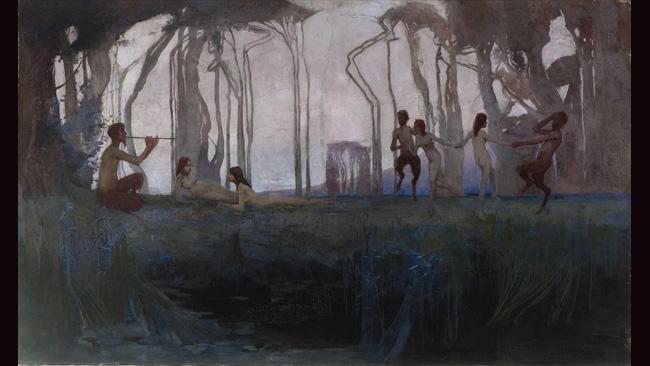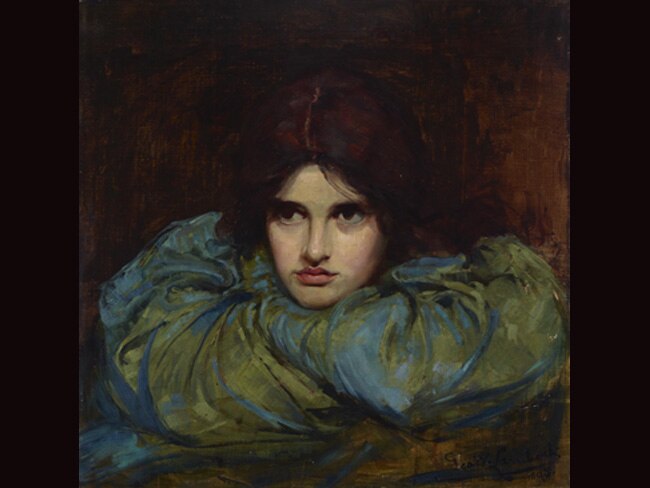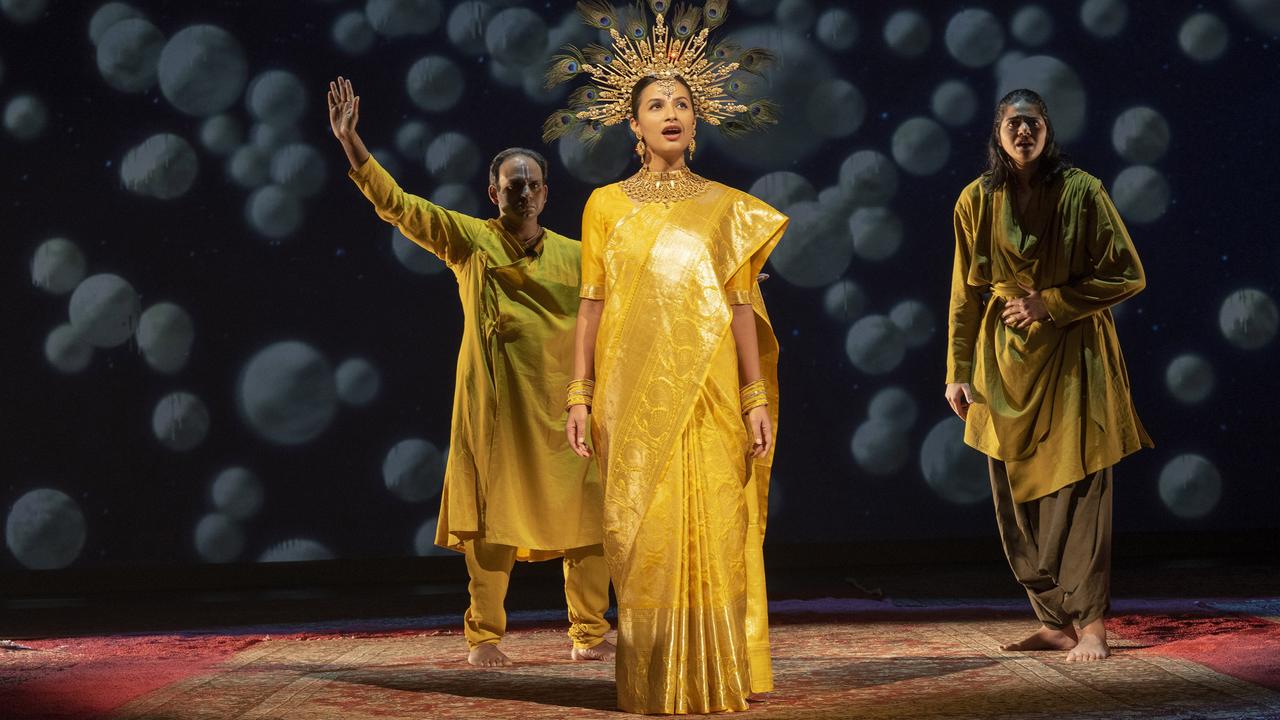Signs of the times evident in AGNSW's Australian Symbolism exhibition
THE thinking of another time can be hard to understand, but the tone and sensibility that make ideas possible is even more mysterious.

THE thinking of another time can be hard to understand - ideas and ideologies once compelling may become unfathomable - but the tone and sensibility that make those ideas possible is even more mysterious.
It is what we intuit, between the lines, in poems, novels or films of the past, as though each time glimpsing another facet of the potential range of human experience; and it is the only way to escape from the unthinking naturalisation of the particular sensibility of our own time, to understand it with critical perspective.
If there is one thing that characterises our present experience, it is the dematerialisation of the world into digital imagery. The mass-production and manipulation of images accelerated throughout the 20th century, but the revolution of the internet, in the past couple of decades, has transformed our relation to images. The static pictures of billboards and advertising have been replaced with ever-moving, ever-changing ones on screens that we conjure up and dismiss at the touch of a button.
The interactivity of the contemporary image economy essentially has made it far more absorbing and even addictive than ever. In numerous domains, from war to sex and including what is known, with unintentionally Orwellian irony, as social media, individuals are drawn into a world of illusion and isolation that undoubtedly has consequences for their experience of the real world - that is, one in which the subject interacts with other people and material objects instead of phantoms that obey his own narcissistic whim.
The 19th century, in contrast, was a singularly material and concrete period. The industrial revolution was rapidly transforming the setting of human life, with growing cities, factories, vast residential quarters and railways carrying the population to their places of work. The signs of material progress were everywhere: scientific knowledge became the touchstone of philosophical thinking for the positivists, while Marx believed that economic and technological development were the real motors of history.
A certain materialistic weight seemed to spread to every part of Victorian culture: architecture and interior design became heavy with ornament, rooms dense and cluttered. Men grew long beards like Old Testament patriarchs; women were dressed in extravagant bustles that concealed their figures; social life lost the aristocratic playfulness of the 18th century and became stuffy with bourgeois respectability.
Even the literary style of the time grew ponderous: gifted authors such as John Ruskin could be verbose and ungifted writers produced the most turgid prose in the history of English literature.
It was against this pervasive materialism that Baudelaire protested - from his famous defence of imagination as the "queen of faculties", which allows us to see the "heroism of modern life" through its banal exterior, to the less well-known observation in one of his notebooks, that true civilisation does not consist in railways and gas lighting but in the reduction of the traces of original sin in the heart of man.
Baudelaire's claims for the imagination and for an anti-materialistic vision of life were given expression in the movement known as symbolism. It appears at the end of the 19th century, partly coinciding with the movements of art nouveau, aestheticism and decadence, as a late form of romanticism which is also a manifestation of modernism. In some cases - with authors such as Lautreamont - it anticipates the surrealists in their revolt against rationality and materialism. In art, the style broadly encompasses painters such as Puvis de Chavannes, Odilon Redon and Gustave Moreau, different though each of these is from the others.
The symbolist tendency in Australian art, which is surveyed properly for the first time in an exhibition at the Art Gallery of NSW, manifested itself in a range of forms, including paintings, drawing and some striking sculpture. It has tended, however, to be overshadowed by the contemporary and more important Heidelberg movement, with painters such as Tom Roberts, Arthur Streeton and Fred McCubbin, who were, for the most part, preoccupied with the material and physical conditions of life in Australia and the proto-nationalist question of making a home in this new environment.
But the opposition between Heidelberg and symbolism is more apparent than real. The aesthetic or Whistlerian tendency in the Heidelberg style can be detected in colour schemes and elsewhere but is particularly evident in the stylised, almost calligraphic treatment of branches and leaves in the foreground of well-known pictures such as Roberts's Artists' Camp (1886) or A Summer Morning's Tiff (1886), although neither of these works is in the present show. The aesthetic strand was like a recessive gene in the make-up of the style, unobtrusively present in the strongest works of the main period of the movement, from 1885 to 1895, but prone to emerging in minor or later pictures, such as those included here.
From the beginning, too, the Heidelberg artists paint the occasional moonlit scene, which is like the reverse or complementary opposite of the daytime subjects, brightly illuminated by a sunlight that comes to epitomise the Australian experience. If the daytime scenes evoke the public dimension of life in Australia, the evening, moonlit scenes allow for the expression of more private and intimate moments, as in Streeton's Above Us the Great Grave Sky (1890).
IN the late phase of Heidelberg and about the period of Federation, many more afternoons, evenings and nights seem to turn up in Australian art. Moonlit scenes and moonrises appear in a surprising proportion of the later works in the exhibition, from David Davies to Charles Conder and Sydney Long, almost as a shorthand sign that the artist is dealing with an inner, imaginative realm as distinct from the outer, objective and material world: the nocturnal landscape lit by the moon is par excellence the scene of dreams or at least of reverie.
This imaginative world, unlike the diurnal and naturalistic one, is often filled with dream figures, allegories and mythological characters. Streeton has a strange and evocative little picture called A Bush Idyll (1896) in which five naked girls dance around in a bushland clearing. The title alludes to the bucolic tradition of Virgil and, still earlier, Theocritus - it was his poems that were first called idylls - but the presence only of female figures is atypical of the genre, which is more often concerned, whether in its literary or pictorial form, with love. No doubt a Victorian audience could accept five naked girls much more readily if there were no naked boys present as well.
Long's Pan (1898), one of the most popular pictures in the gallery, has a slightly more pronounced erotic note thanks to the male presence of the eponymous god, even if the revelry remains rather tame by the standards of Dionysiac orgies. There are similar erotic notes in all the mythological pictures painted about this time, varying from the playful to the wistful and vaporous, but seldom approaching any kind of red-blooded arousal. Rupert Bunny's Pastoral (c.1893), for example, is a collection of tired, melancholy and seemingly exhausted figures.
There are, it should be acknowledged, diurnal mythological figures as well, most notably Conder's Hot Wind (1889) and Streeton's Spirit of the Drought (c.1896). These are very small pictures and marginal to the main body of each artist's work, but they are attempts to give a non-literal, symbolist expression to themes related to those dealt with in the naturalistic narrative and landscape pictures. What they have in common with the other mythological subjects - and Streeton's own Ariadne (1895), which is more successful than Spirit of the Drought - is the attempt to bring poetic meaning and resonance to a land that was devoid of such significance as far as Europeans were concerned.
Inseparable from this search for imaginative meaning in the Australian bush was the interest in intimate domains of experience, both spiritual and sexual, as we have already seen. We are confronted on entering the exhibition by Bertram Mackennal's bronze Circe (1892-93), more impressively installed than I have ever seen her, reaching out towards us in a gesture of enchantment.
Homer's witch, who turns some of Odysseus's men into beasts until he outwits her and makes her an ally, was a subject of fascination in the Victorian period, the epitome of the femme fatale whose frightening and baleful influence could make men forget their better natures. Both this episode of the Odyssey and that of the Sirens, also beautiful temptresses, are frequently represented in 19th-century painting. Circe is a pure evocation of the power of sexuality, completely naked and covered only by the authority of the classical literary reference - a remarkable illustration of the power of classical culture as a bulwark against puritanism, although this exemption was not always recognised by an uncultivated and moralistic local bourgeoisie.
As was mentioned here last year, a religiously motivated campaign to eradicate immoral classical nudes from the Botanical Gardens was successful in Sydney in 1915.
Circe stands on a base decorated with a frieze that alternates surprisingly literal suggestions of couples making love with others that seem to be scenes of mourning. She herself is remarkable for a frankness and boldness that contrasts dramatically with all the figures that surround her in this first room. Almost directly behind her is a reclining nude by Bernard Hall, asleep between two female servants, one of whom is stripped to the waist. The painting belongs to that oddly Victorian genre that has no real subject but refers in some vague way to a pre-Christian world in which nudity and sensuality were innocent of Christian guilt.
The classicising nude thus essentially is used as a respectable way of expressing longing for a sexual freedom condemned by contemporary standards of respectability. Its other function is in the allegorical paintings also popular at the time, such as Hall's rather vapid The Quest (c.1905). But here, and especially in the allegories of Charles Douglas Richardson, the artist strives in vain to turn fleshly bodies, however elongated and etiolated, into ideas. The materialism of the age proves impossible to overcome and the result is inevitable bathos.
Australian Symbolism: The Art of Dreams
Art Gallery of NSW, Sydney, to July 29




